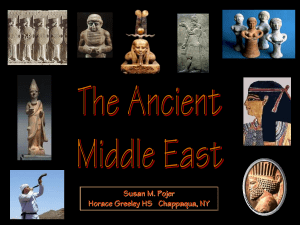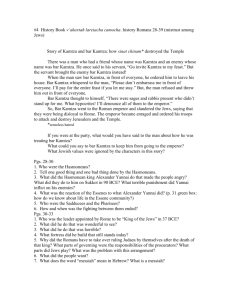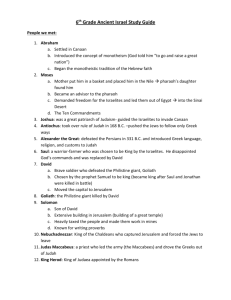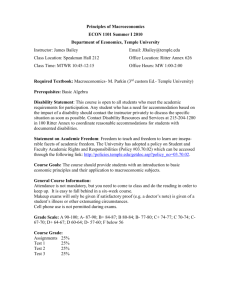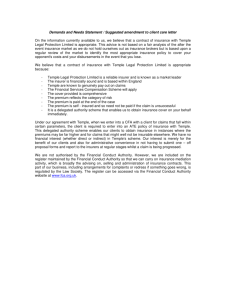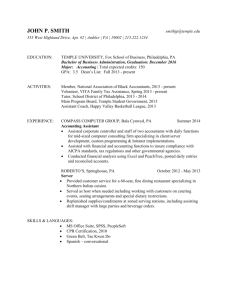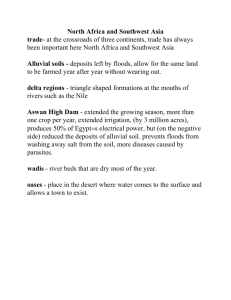Where Jerusalem Jews Worship
advertisement
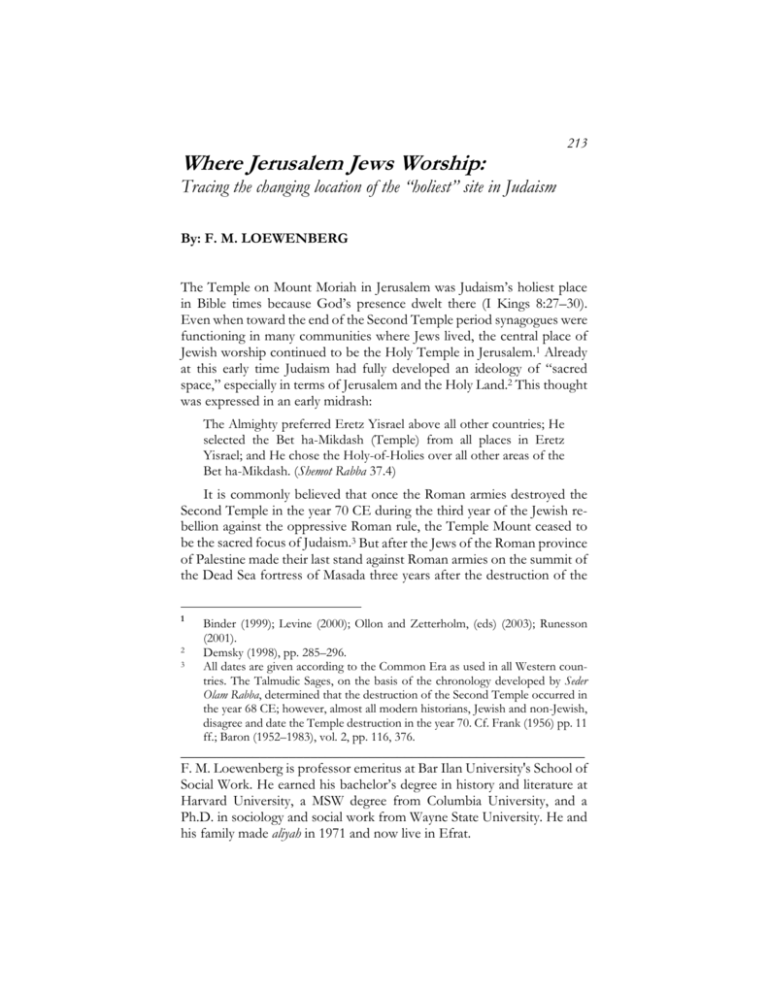
Where Jerusalem Jews Worship: 213 Tracing the changing location of the “holiest” site in Judaism By: F. M. LOEWENBERG The Temple on Mount Moriah in Jerusalem was Judaism’s holiest place in Bible times because God’s presence dwelt there (I Kings 8:27–30). Even when toward the end of the Second Temple period synagogues were functioning in many communities where Jews lived, the central place of Jewish worship continued to be the Holy Temple in Jerusalem.1 Already at this early time Judaism had fully developed an ideology of “sacred space,” especially in terms of Jerusalem and the Holy Land.2 This thought was expressed in an early midrash: The Almighty preferred Eretz Yisrael above all other countries; He selected the Bet ha-Mikdash (Temple) from all places in Eretz Yisrael; and He chose the Holy-of-Holies over all other areas of the Bet ha-Mikdash. (Shemot Rabba 37.4) It is commonly believed that once the Roman armies destroyed the Second Temple in the year 70 CE during the third year of the Jewish rebellion against the oppressive Roman rule, the Temple Mount ceased to be the sacred focus of Judaism.3 But after the Jews of the Roman province of Palestine made their last stand against Roman armies on the summit of the Dead Sea fortress of Masada three years after the destruction of the 1 2 3 Binder (1999); Levine (2000); Ollon and Zetterholm, (eds) (2003); Runesson (2001). Demsky (1998), pp. 285–296. All dates are given according to the Common Era as used in all Western countries. The Talmudic Sages, on the basis of the chronology developed by Seder Olam Rabba, determined that the destruction of the Second Temple occurred in the year 68 CE; however, almost all modern historians, Jewish and non-Jewish, disagree and date the Temple destruction in the year 70. Cf. Frank (1956) pp. 11 ff.; Baron (1952–1983), vol. 2, pp. 116, 376. ________________________________________________________ F. M. Loewenberg is professor emeritus at Bar Ilan University's School of Social Work. He earned his bachelor’s degree in history and literature at Harvard University, a MSW degree from Columbia University, and a Ph.D. in sociology and social work from Wayne State University. He and his family made aliyah in 1971 and now live in Efrat. 214 : Ḥakirah, the Flatbush Journal of Jewish Law and Thought Jerusalem Temple, the rebellion ended and the country was pacified. Now Jews were again permitted to visit Mount Moriah, the site where the Temple had stood only a few years earlier. This “liberal” policy may seem strange to us, but in the ancient world of empire and idolatry it made eminent sense. Idol worshippers, unlike monotheists, have no difficulty in adding yet another god to their pantheon. For the Romans there was no theological problem if the local population wanted to continue to worship its “local god” in the place dedicated to that deity. The Romans had not destroyed the Temple because they wanted to eradicate all worship of the Jewish God, but rather because they believed that the Temple building had served as the hub for the political and military rebellion against the empire. As far as the Roman government was concerned, once the rebellion had been suppressed there was no longer any impediment to the resumption of Jewish worship on the Temple Mount. This is precisely what happened in the first period after the destruction of the Temple. Temple Mount For many years after the Destruction, Jews continued to go on the Temple Mount and pray there, as is confirmed by many stories that appear in both the Jerusalem and the Babylonian Talmud.4 Those wishing to go on the Temple Mount could do so without incurring any halakhic problem since the ashes of the Red Heifer (that were necessary for ritual purification before ascending the Temple Mount) were available for a number of generations after the Destruction of the Temple.5 A story in the Jerusalem Talmud, dated several centuries after the Destruction of the Second Temple, relates how the rabbis would take off their shoes before entering the area of the Temple Mount—a practice that is still observed nowadays when observant Jews go up on the Temple Mount (TP Pesaḥim 7.12 [56a]). During public fast days special prayers, accompanied by the sounding of the ram's horn (shofar), were chanted on the Temple Mount (TB Ta‘anit 15b). Roman Emperor Hadrian, who reigned from 117 to 138, is remembered primarily for his anti-Jewish decrees and for his persecution of the Jews. He attempted to root out the Jewish religion because he believed that it was the root cause of the ongoing Jewish rebellions. He prohibited the study of Torah, abolished the use of the Hebrew calendar, and executed many Jewish scholars. But during the first years of his reign, prior 4 5 See, for example, TB Berakhot 58a; TB Shabbat 15a; TB Rosh Ha-Shanah 31a; TB Sanhedrin 11b; TB Hagigah 15a; TB Avodah Zarah 20a. Brodt (2009). Where Jerusalem Jews Worship : 215 to adopting these anti-Jewish policies, he was eager to gain the cooperation of the Jews; therefore, he allowed them to return to Jerusalem and even granted them permission to rebuild the Temple. The Jews responded eagerly and actively made preparations for restoring the Temple on its original foundations. However, Hadrian, influenced by Samaritan informers, went back on his word and cancelled all building plans. This event took place in the first decades of the second century, during the lifetime of Rabbi Yehoshua ben Hananiah (Genesis Rabba 64.10). Even without a Temple, sacrifices continued to be offered on the Temple Mount for at least 65 years after the destruction of the Temple. This can be deduced from the Mishnah that states that “one may offer sacrifices [on the place where the Temple used to stand], even though there is no House [Temple]” (M Eduyyot 8.6).6 From the time of the destruction in 70 until the end of the Bar Kochba rebellion and the destruction of Beitar in 135, one of the altars on the Temple Mount remained standing on its original site and Paschal sacrifices were offered on it every year.7 Only after crushing the Bar Kochba rebellion did Hadrian order that the Temple Mount be ploughed under and that this altar be completely destroyed. According to most authorities, now it was no longer possible to offer sacrifices, but Rabbi Tzvi Hirsch Chayot (1805, Galicia1855, Russia) thought it likely that the Pascal sacrifice continued to be offered as late as the reign of Emperor Justinian (482–565).8 One of the consequences of the failure of the Bar Kochba rebellion was that Jews were prohibited from ascending on the Temple Mount, as well as from entering the city of Aelia Capitolina, the new name given to the pagan Jerusalem. Hadrian ruled that “… any person contravening this prohibition shall be put to death.”9 However, despite Hadrian's decrees and the destruction of whatever had remained on the Temple Mount, there is ample evidence that pilgrimages to Jerusalem and to the Temple Mount continued for many years after the fall of Beitar.10 This is the context in which some of the Talmudic sages raised the question whether there was still any point in going up to the Temple Mount when it was no longer possible to offer sacrifices there. Rabbi Eleazar ben Pedat (d. 279) was ambivalent, but in the end thought that praying on the Temple Mount still served an important purpose because even though “the gates of 6 7 8 9 10 See also Rambam, Hil. Bet Ha-beḥira 6.15 Ha’emek Davar commentary on Leviticus 26.31. Responses nos. 2 and 76, as well as ch.2 of his Darkei Hora'ah. Harris (1926) 19, 199–206. Avi-Yonah (1984), pp. 79-80. 216 : Ḥakirah, the Flatbush Journal of Jewish Law and Thought prayer are now closed, the gates of weeping are not closed…” (TB Berakhot 32b). The 1930 British Royal Commission that examined the conflicting claims of Moslems and Jews to the Western Wall confirmed that Jews continued to pray on the Temple Mount long after the destruction of the Second Temple. “During the first period after the destruction of the Temple of Herod the Jews continued to go and weep at the ruins of it. According to tradition, the Jews’ wailing-place at that time seems to have been the stone on Mount Moriah where the Mosque of Omar now stands.”11 Mount of Olives Hadrian’s decree made it impossible for Jews to visit the Temple Mount on a regular basis. The only place where they were permitted to assemble for prayer was on the Mount of Olives. The advantage of this location was that it provided an unobstructed view of the Temple Mount and the ruins of the Second Temple. At various times during the next two thousand years Jews did assemble on the Mount of Olives for prayer, but it never became a permanent established place of prayer, nor was it ever the site of a synagogue. An 11th century document indicates that Jews were forced to pay a special tax for the privilege of praying on the Mount of Olives.12 In 1211 three hundred French and English rabbis settled in Jerusalem at the invitation of Saladin. One of these, Rabbi Shmuel ben R. Shimshon, describes in great detail his first days in Jerusalem: We arrived in Jerusalem from the west of the city. When we saw her, we tore kri'ah on our clothes [as a sign of mourning], as is proper. … We went from the city to the Mount of Olives, the place where they used to burn the [Red] Cow – and there we prayed twice with a quorum [minyan]. 13 Even though the central Jewish worship site at this time was on the Mount of Olives, R. Shmuel ben R. Shimshon and other member of his group did not fail to visit the Temple Mount in order to offer their Shabbat afternoon prayers at this site. 11 12 13 Great Britain (1930), pp. 10-11. Bahat (2002), pp. 61–86 at p. 72. Ya’ari (1943), p. 78. Where Jerusalem Jews Worship : 217 Eastern Wall Early in the 14th century Rabbi Ishtori Haparchi (1280–1366), a student of the Rosh and the first Holy Land geographer, wrote in his halakhic and geographic book Kaftor v'Ferah (ch.6) that in his days Jews prayed at the Eastern Wall of the Temple Mount since at that time Jews were not permitted to ascend the Temple Mount itself. Temple Mount (2) A decisive turning point in the history of Western civilization occurred in the fourth century when Christianity became the state religion of the Roman Empire. This change is popularly associated with Emperor Constantine who reigned from 280 to 337. During his reign, interest in the Temple Mount ebbed since Christianity’s central holy site was shifted to the Church of the Holy Sepulcher in the Christian Quarter of the Old City. However, any Temple ruins that still remained were kept in place to serve as a reminder of the “total obliteration” of Judaism as predicted in the Christian writings. These political and religious changes made life for the Jews who had remained in or near Palestine much more difficult. They were allowed access to the Temple Mount only on one day of the year—Tisha b’Av, the anniversary of the day when the Second Temple was destroyed. Two Christian writers, the Pilgrim from Bordeaux who came on a pilgrimage to the Holy Land in 333 and, seventy years later, Jerome (347–420), the monk and translator of the Bible into Latin, provide almost identical descriptions of these annual Tisha b’Av visits to the Temple Mount. Jerome chronicles with evident relish how the Jews had to bribe the Roman soldiers for permission to lament at their holy site, how a whole people came mourning, women feeble with age, old men burdened with years, etc.14 Constantine’s nephew Julian (born in 332) became emperor in 361. He had been raised as a Christian, but rejected this religion as an adult and is known as the “apostate” emperor. He felt a deep revulsion toward Christianity from an ethical-religious viewpoint and believed that the recognition of Christianity had been a political disaster for the Roman Empire. He gave practical expression to his antagonism to Christianity by creating a new pagan cult in which he served as High Priest. Julian wanted to form a common cause with the Jews in his fight against Christianity, as well as for his conquest of Persia. Therefore he promised them that he would do his utmost to rebuild the Temple in Jerusalem. This was another way in which he tried to attack the established Christian church. 14 Jerome’s commentary on Zephaniah 1.6. 218 : Ḥakirah, the Flatbush Journal of Jewish Law and Thought Diaspora Jews greeted Julian’s plan to rebuild the Jerusalem Temple with great enthusiasm. Many contributed large sums of money to the project. But the Sages were apprehensive about participating because they feared the consequences if the project failed. They remembered the severe anti-Jewish persecutions that followed the unsuccessful Jewish revolt against the cruel rule of Constantius Gallus, brother-in-law of Emperor Constantius II and Caesar of the East, a decade earlier. Nevertheless many Jews came to Jerusalem to assist the skilled craftsmen and masons who were working on the Temple Mount. But progress was slow and work on rebuilding the Temple’s foundation advanced only haltingly—even though the imperial treasury supplied large sums of money and all necessary building materials. Soon after the building was begun, mysterious balls of fire erupted and killed many of the construction workers at the site. All work was halted abruptly. After Julian was killed in battle, he was succeeded by a pious Christian emperor who cancelled all of Julian's “reforms,” including the building of the Temple, and reinstated all the earlier anti-Jewish decrees that Julian had cancelled. Though the Temple was not rebuilt at this time, some time later the Jews did erect a synagogue on the Temple Mount; we learn this from the accounts of the Christian historian Philostorgious (Greece, 368–469). We also know from the Babylonian Talmud that Jews did go up and pray on the Temple Mount in the fourth century since Rabbi Bibi, who lived at that time, instructed them not to spit on the Temple Mount, not to carry a walking stick, not to wear shoes, not to carry a coin purse, and not to use the Temple Mount as a short cut––because all these behaviors degrade the holiness of the place (TB Berakhot 62b).15 But for the 5th and 6th centuries there are no records to indicate that Jews were allowed to pray on the Temple Mount. Temple Mount (3) King Khosru II of Persia (591–628) invaded Palestine in the second decade of the seventh century; this campaign was part of his attempt to reestablish the ancient Achaemenid Empire. Prior to conquering Jerusalem, Khosru promised the Jews of Palestine that a Jewish governor would be appointed as ruler over the city. He did appoint Nehemiah son of Hushiel as governor of Jerusalem. Once appointed, Nehemiah proceeded to reestablish the sacrificial service on the Temple Mount. Rabbi Elazer Kalir, one of the earliest and most prolific of Jewish liturgical poets who 15 Similar instructions can also be found in several earlier and later sources, including Mishnah Berakhot 9.5 and Midrash Tanḥuma, Vayikra 6. Where Jerusalem Jews Worship : 219 lived in Palestine at the time of the Persian invasion, described these events in one of his liturgical poems (piyutim) as follows: When Assyria [Persia] came to the city … and pitched his tents there / the holy people [Jews] were a bit relieved / because he permitted the reestablishment of the Temple / and they built there the holy altar / and offered upon it holy sacrifices / but they did not manage to build the Temple / because the Messiah had not yet come.16 But the Persians executed Nehemiah before long. Perhaps they feared his messianic pretensions—or they suspected that he was planning to organize a rebellion or they made a strategic decision that the support of the larger Christian population was more valuable than the support of the smaller number of Jews living in Palestine.17 The Persian control of the city did not last long. The Byzantine emperor Heraclius (575–641) waged a bitter war against the Persians to regain his lost provinces of Syria, Egypt and Palestine. He successfully destroyed the Persian army in 628 and in the following year marched at the head of his army into Jerusalem. This renewed Byzantine rule of the city also proved to be short-lived. Jerusalem was conquered by the Muslims in May 637. The Roman governor of Jerusalem abandoned the city as soon as he learned that the Byzantine army had been defeated by the Muslims at Al-Yarmouk. He left the inhabitants to negotiate their own surrender. Jerusalem’s Jews welcomed the Arab army that now occupied the city. A letter written by a Jew in the 11th century describes how these Jews showed Omar the exact spot where the Temple once stood. In return for this service they received a number of concessions, including the right to reside in Jerusalem, the assignment to keep the Temple Mount clean, and, perhaps most important, permission to pray on the Temple Mount without interference.18 Reversing the Byzantine Christian rulings that for centuries had prohibited any Jewish presence in the city, the Muslims permitted, even encouraged, their return. Jews once again played a crucial role in reviving the centrality of the Temple Mount, for Muslims as well as for Jews. A document found in the Cairo Geniza describes the arrival of a group of Jews on the Temple Mount, immediately after the Muslim conquest: 16 17 18 Fleischer (1985), p. 401. This poem, recovered from the Cairo Geniza, is not found in the modern liturgy. Sefer Zerubabel, pp. 55–88 in Even Shmuel (Kaufman) (1943); Bekkum (2002). See also Baron (1957), vol. 3, p. 239, n. 25. Mann (1920), vol. 2, pp. 188-89. 220 : Ḥakirah, the Flatbush Journal of Jewish Law and Thought And all the Muslims that lived in Jerusalem and in the neighboring towns came [to the Temple Mount] and with them came a group of Jews. And Omar ordered them to sweep the rubbish that had been deposited there over the past few centuries and clean the place of the Temple. Omar interrogated them all the time, and every time they exposed another layer, he asked the Jews if this was the Foundation Stone.19 Evidently at this time Jews received permission to build a synagogue or prayer-and-study hall on the Temple Mount. Some authors even state that the first wooden structure built over the Foundation Stone was meant to be a synagogue, but that before it was completed the Muslims expropriated the building and gave the Jews another site on the Mount.20 Petachiah of Regensburg, a Bohemian rabbi who arrived in Crusader Jerusalem no later than 1187, reported that in his days it was “common knowledge” that the Dome of the Rock (he called it the Omar-mosque) was originally designed to serve as a synagogue.21 The 7th Century Armenian bishop and historian Sebeos confirmed the existence of a prayer hall on the Temple Mount. He wrote as follows: After the Jews enjoyed the aid and protection of the Arabs for a long time, they conceived the idea of rebuilding the Temple of Solomon. They identified the location of what they called “The Holy of Holies” and there they built a prayer-hall, using the foundations and the remnants of the original building. Once they had started to build, the Arabs became jealous and banished them from there. Instead, they gave the Jews another area on the Temple Mount for a synagogue.22 Solomon ben Jeroham, a Karaite exegete who lived in Jerusalem between 940 and 960, wrote in his commentary on the Book of Psalms that the Muslims had permitted the Jews to pray on the Temple Mount for many years. 19 20 21 22 Yaari (1943), pp. 47-48. According to the Sages the Foundation Stone was the rock from which the world was created [TB Yoma 54b]. The first mention of this stone in Jewish sources is in Mishnah Yoma 5:2. In the 16th century, Jerusalem’s chief rabbi confirmed that “under the dome on the Temple Mount, which the Arabs call El-Sakhrah, is without a doubt the location of the Foundation Stone” [Radbaz, Responsa, vol. 2, no. 691]. However, not all authorities agree with this conclusion. Many reject the identification of the stone under the Dome of the Rock with the Foundation Stone. See Goren (2004), p.309. Author unknown (2001). Benisch (1856). Sebeos (1985), ch. 31. Where Jerusalem Jews Worship : 221 When, with the mercy of the God of Israel, the Romans were thrown out [of Jerusalem] and the Islamic kingdom appeared, permission was given to Israel to enter [the city] and live there. Furthermore, the courtyards of the Temple were turned over to them and they prayed there [on the Temple Mount] for many years. Afterwards [slanderers] told the Muslim king that they did bad things there, that they drank intoxicating wine and desecrated the place. He therefore ordered them expelled to one of the many gates and there they prayed for many years. But they continued to do bad things and there came a new king and he expelled them from the Temple Mount completely.23 But there were times when Jews were prohibited from going on the Temple Mount. An 11th century document found in the Cairo Geniza describes how Jewish pilgrims frequently circled the Temple Mount (from the outside) and stopped at each of the gates in order to recite prayers. This “pilgrim guide” noted that inside the Hulda Gate there was once a place of Jewish worship and that the names of many Jewish pilgrims were chiseled on the walls.24 Praying at the Temple Mount gates was apparently popular in the 11th century because prayer on the mount itself was not allowed. Thus, Moshe b. Yizḥak (mid-11th century) is reported to having prayed daily at one of the Temple Mount gates. Another document written in 1057 confirmed that the Jews paid special taxes for the privilege of praying at the Temple Mount gates and on the Mount of Olives.25 The fate of the synagogue on the Temple Mount was discussed in a letter written a short time after 1099 by the Spanish Jewish leader R. Abraham bar Hiyya Ha-Nassi (1065/1070–1136, Spanish mathematician and philosopher). He wrote that the synagogue on the Temple Mount had been destroyed soon after the Crusaders captured the city. But the Jewish traveler Benjamin of Tudela who visited Jerusalem during the Crusader years reported that Jews continued to pray on the Temple Mount. He wrote in his travelogue: In front of the [Dome of the Rock] is the Western Wall. This is one of the [remaining] walls of what was once the Holy of Holies [of the Second Temple]. … All the Jews come there to pray before this wall.26 23 24 25 26 Comment on Psalms 30, cited by Goren (2004), p. 314. Bahat (2002), p. 70. Bahat (2002), p. 72. Benjamin of Tudela (1960), p. 24. The exact date of his visit in Jerusalem is not known. He left Tudela, Spain, between 1159 and 1163, and returned in 1172, so that his visit to Jerusalem occurred during the Crusader era. 222 : Ḥakirah, the Flatbush Journal of Jewish Law and Thought The Western Wall that Benjamin described in his travelogue was not the present Western Wall (which is part of the retaining walls of the Herodian Temple Mount and which did not become a site for prayer until the 16th century) but the ruins of the western wall of the Second Temple building itself. Saladin (1137/1138–1193), Sultan of Egypt, led the Islamic forces in recovering the lands captured by the Crusaders. His armies regained control of Jerusalem in October 1187, immediately after they decisively defeated the Crusader army in the battle of Karnei Hittin in the Lower Galilee. Not only did Saladin permit Jews and Muslims to return and settle in the city, but he also allowed Jews to worship on the Temple Mount. Saladin, as well as the sultans of the Ayyubid dynasty who succeeded him, encouraged the construction of dwelling houses, markets, public baths, and pilgrim hostels, as well as the establishment of Muslim religious endowments. Though the Temple Mount was re-consecrated as a Muslim sanctuary, the Muslim authorities acknowledged that the Jews had a right to erect a synagogue on the Temple Mount.27 The Temple Mount as a central place of Jewish worship seems to have had a checkered history during the next few centuries when the city was under Mamluk rule (1247–1517). The Mamluks came from Mongolia where they had been kidnapped to serve as slaves in the Muslim armies. In time they became devout Muslim rulers of Egypt, Palestine and Syria. They emphasized the religious status of Jerusalem by building mosques, madrassas (educational institutions), and other religious structures throughout the city and especially on the Temple Mount. Their attitude toward Jews and other non-Muslims was generally negative, though in practice their policy was inconsistent. Rabbi Ishtori Haparchi, as noted above, wrote that early in the 14th century Jews no longer prayed on the Mount, but at the Eastern Wall and outside the gates of the Southern wall (Kaftor v'Ferah, ch. 6). Rabbi Menachem Meiri (1249–1316), a famous Talmudic scholar who lived in southwestern France and never visited Jerusalem, had no doubts that in his days Jews entered the Temple Mount in order to pray there. He wrote, “We have heard that it is the accepted custom to enter [the Temple Mount].”28 When Rabbi Meshulam Da Volterra, an Italian Jewish pilgrim, 27 28 Offenbacher (1985), p. 134, citing Berkovicz (1978). Beit Ha-b'ḥira on TB Shavuot 16a. Rabbi Yehudah Gershuni (1909–2000), a renowned Jerusalem rabbinic scholar of the last generation, wrote in his book Sefer Ḥochmat Gershon (p. 238) that a number of later scholars (aḥaronim) supported Meiri’s position on the basis that (according to the Mishnah in TB Ta‘anit 19a) Where Jerusalem Jews Worship : 223 visited Jerusalem in 1481, the Jews of Jerusalem did not ascend the Mount—even on Tisha b’Av, as had been the custom in earlier periods. He wrote: And all the community of Jews, every year, goes up to Mount Zion on the day of Tisha B’Av to fast and mourn, and from there they move down along Yoshafat Valley and up to Mount of Olives. From there they see the whole Temple [Mount] and there they weep and lament the destruction of this House.29 On the other hand, Rabbi David ben Shlomo Ibn Zimra, (known as the Radbaz, 1479–1573), chief rabbi of Jerusalem in the 16th century, wrote that in his day all of the city’s Jews regularly went up to the Temple Mount in order to view the entire Temple ruins and pray there. He added that “we have not heard or seen anyone object to this.”30 Western Wall In 1517 the city of Jerusalem “switched” allegiance from the Egyptian Mamluks to the Ottoman Empire of Sultan Selim I, thus placing itself under Ottoman control for the next four hundred years. Selim’s son Sultan Suleiman I the Magnificent assumed the throne upon his father’s death three years later. Suleiman embarked on an ambitious series of public works projects in many of the major cities of the Islamic world. His projects in Jerusalem included an extensive renovation of the Dome of the Rock and a rebuilding of the walls of the city. Fourteen years later in 1550 he instructed his court architect to prepare the Western Wall of the Temple Mount as a place for Jewish prayer. There had never before been a prayer site at this location. Even though there is an ancient tradition that “the Shechina will never move from the Western Wall” (Shemot Rabba 2.2, Yalkut Shimoni on 1 Kings 8.195), this saying referred to the western wall of the Temple building and not to the present Western Wall, which is part of the retaining wall of the Temple Mount. But because nothing remains of the original Temple wall, this saying is nowadays often applied to the current Western Wall. Suleiman issued a firman (royal decree) that established for all times the right of Jews to pray at the Western Wall. 29 30 many Jerusalemites would escape from the city during periods of heavy rains by going up on the Temple Mount. Note in this connection also the comment of Rabbi Abraham ben David of Posquieres (known as the Ravad, 1125–1198) that “one who enters the Temple Mount nowadays is not punished by excision.” Comment to Maimonides, H. Bet Ha-Beḥira 6:14 and 6:16. Ya’ari (1959), p. 68. Responsa of the Radbaz, v. 2, no. 691. See Sagiv (2003) for the full text and a critical analysis of this response. 224 : Ḥakirah, the Flatbush Journal of Jewish Law and Thought Some say that this decree was issued to compensate the Jews for relinquishing their legal rights to pray on the Mount itself. There is no record, however, that Jews ever relinquished these rights voluntarily. While this was a unilateral decision, it is important to note that the Muslim ruler who issued this decree acknowledged that Jews had had rights on the Temple Mount since ancient times. This firman was still in effect in the nineteenth century. One observer noted, No one is molested … by the Mahomedans, as we have a very old firman from the Sultan of Constantinople that the approach [to the Western Wall] shall not be denied to us, though the Porte obtains for this privilege an especial tax, which is, however, quite insignificant. 31 Once the Ottoman authorities designated the area in front of the Western Wall32 as the official central place of Jewish worship, Jerusalem rabbis began to issue halakhic prohibitions that forbade entrance of Jews on the Temple Mount. The stated reason for these rabbinical prohibitions was the uncertainty of determining the exact location where the Temple once stood. Since Jews are prohibited from entering that area under pain of death, many of the rabbis ruled that the entire Temple Mount is “offlimits.” But it may well be that at that time a more persuasive reason for this prohibition was their desire to preempt the Ottoman rulers’ ban against the entrance of any non-Muslim on the Temple Mount. In the first few centuries after the Western Wall was designated as the central Jewish place of prayer it was used infrequently, certainly not as regularly as nowadays. Early descriptions indicate that only people who faced a very grave problem came to the Wall to pray for Divine help. Another custom recorded in the annals of the Jerusalem community was for Jews to assemble at the Wall to recite evening prayers (Maariv) and elegies (kinot) during the ten days following Rosh Hodesh Av; others came on Thursday nights to recite tikkun ḥazot, a special midnight prayer asking for God’s mercies. A third custom was for the especially pious to assemble near the Western Wall on Friday afternoons to welcome the Sabbath (kabalat Shabbat). Still others had the custom of reciting the Musaf prayer on Sabbaths and holydays at the Western Wall. Reb Gedalyah who came to Jerusalem from the city of Siemiatyce, Poland, in October 1700, together with the group led by Rabbi Yehudah Ha-hassid, described the minor role that the Western Wall played in Jerusalem Jewish life at the beginning of the 18th century: 31 32 Schwartz (1850), p. 260. Until 1967 the area was only a narrow alley. Where Jerusalem Jews Worship : 225 Every Shabbat morning, immediately after leaving the synagogue, [Jerusalem Jews] walked to the Western Wall, but actually [they did] not walk to the Western Wall because it was far away and it was necessary to walk through the alleys and market places in white Shabbat coats … but [they] walked to a certain alley where Jews live and from a high spot one can see, beyond the Western Wall, the place of the Temple … and there [they said] those psalms that mention Jerusalem and Zion.33 A 19th-century observer reported: This wall is visited by all our brothers on every feast and festival; and the large space at its foot is often so densely filled up, that all cannot perform their devotions here at the same time. It is also visited, though by less numbers, on every Friday afternoon and by some nearly every day.34 But there is no record of regular prayer services, three times a day, at the Western Wall until the 20th century.35 Following the 1948 War of Independence, the Jordanian army occupied East Jerusalem, including the Old City and all of its Christian and Jewish holy places. For nineteen years no Jew was allowed to approach the Western Wall. This absolute ban was strictly enforced, despite provisions in the Armistice Agreement that called for free access to all holy places in Jerusalem. On the second day of the 1967 Six Day War, Israeli paratroopers entered Jerusalem’s Old City by way of the Lion’s Gate, the easternmost entrance to the city, and made their way to the Temple Mount and Western Wall. Rabbi Shlomo Goren (1917–1994), chief rabbi of the Israeli army, appeared on the Temple Mount within minutes after the first troops entered the area. He described how he blew the shofar and then fell on the ground and prostrated himself in the direction of the Holy of Holies, as was customary in the days when the Temple still stood. Immediately afterwards he descended from the Temple Mount to the Western Wall in order to pray there the Minḥa prayer. This was the first prayer service at the Western Wall in 19 years. Ever since then this is considered “the holiest place” in Judaism. Temple Mount (4) 33 34 35 Ya’ari, (1976), pp. 345-346. Schwartz (1850) p. 260. Gliss (n.d.), citing Keter Shem Tov. 226 : Ḥakirah, the Flatbush Journal of Jewish Law and Thought None of the sources that we have examined mention any prayers on the Temple Mount during all the years of Ottoman and British Mandatory rule of Jerusalem. Though many non-religious Jews visited the mountain during the last decades of the Ottoman period, the Jerusalem rabbinate consistently opposed the entry of Jews on the Temple Mount. In the years following World War I when the country was ruled by the British, the Jerusalem rabbis continued to insist on this prohibition. Rabbi A. Y. Kook, the first Ashkenazi chief rabbi of the Holy Land, did not revoke the prohibition, preferring to leave things as they were. He explained a number of times that Jews were not permitted to go up to the Mount because the exact location of the holy sites could not be determined.36 His successor, Rabbi Yizchak Isaac Halevi Herzog (1888–1959), testified before the British Partition Committee in 1938 that Jews are not allowed to go onto the Temple Mount until the coming of the Messiah. Prior to the War of Independence which established the State of Israel, General David Shaltiel (1903–1969), the commanding general of the Haganah, the Jewish underground forces in the Jerusalem sector, consulted with Chief Rabbi Herzog about the forthcoming war. The rabbi instructed the general that if his forces captured the Temple Mount, they should make every effort to expel all of the enemy forces—but once they had accomplished this, they should leave the Temple Mount as quickly as possible because of the holiness of the place. But Israel failed to capture the Temple Mount at that time; instead it was occupied by Jordanian forces until 1967. A new period in the Temple Mount history began in 1967 when Israeli paratroopers captured Jerusalem’s Old City, including the Temple Mount and the Western Wall. Once General Motta Gur (1930–1995), the commanding general of the paratrooper brigade that recaptured the Old City, reached the Temple Mount he ordered three paratroopers to climb to the top of the Dome of the Rock and unfurl an Israeli flag over it. Four hours later Defense Minister Moshe Dayan ordered that this flag be taken down immediately. On that day Dayan also issued two other orders that would affect the future of the Temple Mount for generations: [1] He placed the administration of the Temple Mount in the hands of the Muslim Wakf 36 See, for example, Kook (1966), p. 202, H. Beit Habeḥira, par. 96. In this ruling R. Kook followed most medieval and contemporary halakhic codes—for example, Rabbi Abraham Gombiner (c.1633–c.1683) wrote that “one who enters nowadays the place where the Temple used to stand incurs the punishment of excision (karet)” (Magen Avraham OḤ 561.2). Rabbi Yisrael Meir Kagan, known as the Ḥafetz Chaim (Poland, 1838–1933), used the very same words in his authoritative legal commentary Mishnah Berurah (561.5). Where Jerusalem Jews Worship : 227 and [2] he ordered that the Temple Mount be open for Jews, but prohibited them from praying there. Dayan explained these decisions by saying, We should certainly respect the Temple Mount as an historic site of our ancient past, but we should not disturb the Arabs who were using it for what it was now - a place of Moslem worship.37 Rabbi Shlomo Goren appeared on the Temple Mount before Dayan ordered the removal of the Israeli flag from the top of the Dome of the Rock. This is how he described his activities on that day: When we arrived on the Temple Mount, I blew the shofar, fell on the ground and prostrated myself in the direction of the Holy of Holies, as was customary in the days when the Temple still stood. [Afterwards he descended to the Western Wall and prayed the Mincha prayer.] I then went up again on the Temple Mount. There I found General Moti Gur sitting in front of the Omar Mosque. He asked me if I wanted to enter and I answered him that today I had issued a ruling permitting all soldiers to enter because soldiers are obligated to do so on the day when they conquer the Temple Mount in order to clean it of enemy soldiers and to make certain that no booby traps were left behind. … I took along a Torah scroll and a shofar and we entered the building. I think that this was the first time since the destruction of the Temple almost two thousand years ago that a Torah scroll had been brought into the holy site which is where the Temple was located. Inside I read Psalm 49, blew the shofar, and encircled the Foundation Stone with a Torah in my hand. Then we exited.38 While Rabbi Goren was at the Western Wall, another group of soldiers had entered the Temple Mount to drive out any remaining Jordanian soldiers. While on the Mount, they conducted the Mincha payer service inside the Dome of the Rock!39 This was the first Jewish prayer service on the Temple Mount in more than 400 years. Some weeks later Rabbi Goren established a synagogue and study hall on the Temple Mount. But within days the Israeli government, at the behest of Minister Moshe Dayan, ordered Rabbi Goren to cease all activities on the Mount. As a result of the government’s decision in 1967, the general public, including Jews and Christians, are now allowed to visit the Temple Mount during a few specified hours five days a week, but they are not allowed to 37 38 39 Dayan (1976), pp. 387–390. Goren (2009). Shefer (2007), p. 8. 228 : Ḥakirah, the Flatbush Journal of Jewish Law and Thought pray there. Many visitors have taken advantage of this permission to visit the Temple Mount, but most observant Jews have continued to refrain from entering the Mount because of the prohibition of the Chief Rabbinate. A small number of rabbis have followed Rabbi Goren’s plea to permit Jews to enter those areas on the Temple Mount that do not require complete ritual purity. The late Rabbi Tzvi Yehuda Kook, dean of the Mercaz Harav Yeshiva and considered by many as the leading rabbinical authority in the National Religious sector, attacked those rabbis who after the 1967 Six Day War ruled that ascent to the Temple Mount was permissible.40 Yet in recent years the number of observant Jews who ascend the Temple Mount has increased dramatically. But they are not allowed to pray there. The police will arrest anyone whom they suspect of violating this noprayer order. Many appeals have been made to Israel’s Supreme Court to permit Jews to pray on the Temple Mount. Despite the 1967 Law for the Protection of Holy Places, which allows free access and freedom of worship to all religions, Jews alone are prohibited from praying on the Temple Mount, ostensibly to ensure public order. The late Justice Menachem Elon, Deputy Chief Justice of the Supreme Court, explained this prohibition by the fact that “the Temple Mount possessed extraordinary sensitivity that has no parallel anywhere.”41 At the outbreak of the Second Intifada in September 2000, the government closed the Temple Mount to all non-Muslims in order to prevent further clashes with the Palestinians. The Temple Mount was reopened to non-Muslims in August 2003, but visits were limited to Sundays through Thursdays, 7:30 a.m. to 10 a.m. and 12:30 p.m. to 1:30 p.m., and not on any Christian, Jewish or Muslim holidays or other days considered “sensitive” by the Waqf, the Muslim custodians of the Temple Mount. During the permitted hours, Jews and Christian are allowed to go up to the Mount if they conform to a strict set of guidelines, which includes the demand that they not pray or bring any “holy objects” to the site. Visitors are banned from entering any of the mosques without direct Waqf permission. These rules are enforced by Waqf agents, who watch tours closely and alert nearby Israeli police to any breaking of the rules. Despite the fact that the Israeli Knesset passed laws to ensure freedom of worship to all at all holy sites, Jewish prayer on any part of the Temple Mount continues to be prohibited. Public Security Minister Avi 40 41 Korn (1977). H.C. 67/93, H.C. 222/68. See also Catholic University of America (1996); Cohen (1999). Where Jerusalem Jews Worship : 229 Dichter once again stated the government's official policy regarding Jewish prayer on the site of the Holy Temple: “Jews may pray on their holiest site - but only in their heart; no lip-moving allowed.”42 All agree that the Temple Mount is the holiest Jewish site, but as of this writing it has not yet again become the central Jewish place of worship as it was many times in the past. Our prayer is that soon, in our days, it will once again serve that function. 42 Israel National News, 2 January 2008. It seems that there are exceptions to every regulation, including the current police order that prohibits Jewish prayer on the Temple Mount. For example, a group of rabbis publicly recited the Priestly Blessing on the Temple Mount, an act that under normal circumstances would result in the arrest of all those participating (Israel Today Headline News, 22 October 2007). 230 : Ḥakirah, the Flatbush Journal of Jewish Law and Thought Bibliography Avi-Yonah, Michael. (1984). The Jews of Palestine: a political history from the Bar Kokhba war to the Arab conquest. Jerusalem: Magnes Press. Bahat, Dan. (2002). “Identification of the Gates of the Temple Mount and the ‘Cave’ in the Early Muslim Period,” Catedra 106, pp. 61–86. [Hebrew]. Baron, Salo Wittmayer. (1952–1983). A Social and Religious History of the Jews. 2nd ed., revised and enlarged. Philadelphia: Jewish Publication Society. Bekkum, Wout Jac van. (2002), “Jewish messianic expectations in the age of Heraclius.” In Gerrit J. Reinink and Stolte, Bernard H, The Reign of Heraclius (610–641, Leuven:Peeters, pp.95–112. Benisch, A. (1856). Travels of Petachia of Ratisbon. London. [Critical Hebrew edition by Greenhut, Eliezer. Jerusalerm. Hebrew University. 1966.] Benjamin of Tudela. (1960). The Itinerary of Benjamin of Tudela. Jerusalem. Hebrew University. Based on Adler’s edition of 1907. [Hebrew]. Berkovicz, S. (1978). The Legal Status of the Holy Places in Israel (doctoral dissertation, Hebrew University). [Hebrew]. Binder, Donald D. (1999). Into the Temple Courts: The Place of the Synagogues in the Second Temple Period. Atlanta: The Society of Biblical Literature. Brodt, Eliezer. (2009). How long were the ashes of the Red Heifer available? http://seforim.traditiononline.org/index.cfm/2009/7/2/--------. [Hebrew]. Catholic University of America. (1996). “Symposium on Temple Mount Faithful v. Attorney-General,” The Catholic University of America Law Rev. 45(3), pp. 861–941. Cohen, Yoel. (1999), “The Political Role of the Israeli Chief Rabbinate in the Temple Mount Question,” Jewish Political Studies Review, 11 (1-2), pp. 101– 126. Dayan, Moshe. (1976). Story of My Life. New York: Morrow and Company Demsky, Aaron. (1998). “Holy City and Holy Land as Viewed by Jews and Christians in the Byzantine Period: A Conceptual Approach to Sacred Space,” Sanctity of Time and Space in Tradition and Modernity, edited by A. Houtman, M. J. H. M. Poorthuis, and J. Schwartz, Leiden, pp. 285–296. Even Shmuel (Kaufman), Yehudah. (1943). Midrashei G'ulah. Tel Aviv: Mossad Bialik Fleischer, Ezra. (1985). “L'pitaron sh'elat z'mano u'makom p'uloto shel R’ Elazar Biribi Kilir” [“Towards a Solution to the Question of the Time and Place of Activity of Rabbi Elazar ben Rabbi Kalir”], Tarbiz 54, pp. 383-428. Frank, Edgar. (1956). Talmudic and Rabbinical Chronology. New York: Feldheim. Gershuni, Yehudah. (5757/1997). Sefer Ḥochmat Gershon. Jerusalem. Gliss, Yaakov. (n.d). Minhagei Eretz Yisrael. Jerusalem. [Hebrew] Goren, Shlomo. (2004). Sefer Har Habayit [Book of the Temple Mount]. Rev. ed., Jerusalem. [Hebrew]. Where Jerusalem Jews Worship : 231 ---. (2009). Selection from Personal Diary on the Conquest of Jerusalem. Cited in Shabbaton, no. 422, 6 Sivan 5769. Great Britain. Commission for the Wailing Wall. (1930). Report of the Commission appointed by H. M. government... to determine the rights and claims of Moslems and Jews in connection with the Western or wailing wall at Jerusalem. Harris, J. R. (1926). ‘Hadrian’s decree of expulsion of the Jews from Jerusalem,’ Harvard Theological Review 19, 199–206. Kook, Rabbi Avraham Isaac. (1966). Mishpat Cohen, Jerusalem. Korn, Zalman. (1977). B'hazrot Beit Hashem [In the Temple’s Courtyard]. Jerusalem. [Hebrew]. Levine, Lee. (2000). The Ancient Synagogue: The First Thousand Years (2nd ed.). New Haven, Conn.: Yale U, Press. Mann, J. (1920). The Jews in Egypt and in Palestine under the Fatimad Caliphate. Ithaca, NY: Cornell University Library. Offenbacher, E. (1985). Prayer on the Temple Mount. Jerusalem Quarterly 36, pp. 129–140. Ollon, B. and Zetterholm, M. (eds). (2003). The ancient synagogue from its origins until 200 C.E. Stockholm: Almqvist & Wiksell International. Runesson, A. (2001). The origins of the synagogue: a socio-historical study. Stockholm: Almqvist & Wiksell International. Sagiv, Tuvya. (2003). “Ha-knissa l'Har Habayit–T'shuvat Haradbaz” [Entering the Temple Mount–the Decision of the Radbaz], pp. 46–81 in Kumo vNa'aleh, ed. Yehuda Shaviv. Alon Shvut: Machon Tzomet. Schwartz, Joseph. (1850). Geography of Palestine, (trans. I. Leeser). Philadelphia. [Original Hebrew: Tevuot HaAretz. 1845; ed. A.M. Lunz, 1900]. Sebeos. (1985). Sebeos’ History, transl. Robert Bedrosian, New York. Shefer, Eliezer. (2007). Miyom Yerushalayim Harishon v'ad Hayom. Jerusalem. [Hebrew] Ya’ari, Abraham. (1943). Igarot Eretz Yisrael (Eretz Yisrael Letters). Tel Aviv. [Hebrew] ---. (1959). Massa Meshulam of Volterra.Jerusalem, Mossad Bialik. [Hebrew] ---. (1976). Massa'ot Eretz Yisrael (Travels to Eretz Yisrael). Tel Aviv. [Hebrew] [Author unknown]. “The riddle of the Dome of the Rock: Was it built as a Jewish place of prayer?” The Voice of the Temple Mount Faithful, Summer 5761–2001.
